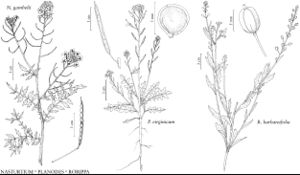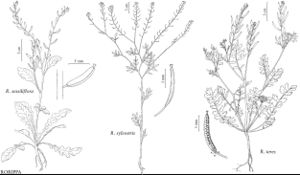Rorippa
Fl. Carniol., 520. 1760.
Annuals, biennials, or perennials; (usually aquatic or of mesic habitats, rhizomatous, sometimes with caudex); not scapose; glabrous or pubescent. Stems erect or prostrate, unbranched or branched. Leaves basal and/or cauline; petiolate or sessile; basal (usually withered early), rosulate or not, petiolate, blade margins entire, dentate, sinuate, lyrate, pectinate, or 1–3-pinnatisect; cauline petiolate or sessile, blade (base cuneate, attenuate, auriculate, or sagittate), margins entire, dentate, pinnatifid, or pinnatisect. Racemes slightly to considerably elongated in fruit. Fruiting pedicels erect, suberect, ascending, horizontal, reflexed, or divaricate, usually slender. Flowers: sepals (rarely persistent), erect or spreading, ovate or oblong, lateral pair not or, rarely, saccate basally, (margins often membranous); petals (rarely vestigial or absent), often yellow, sometimes white or pink, usually obovate, spatulate, oblong, or oblanceolate, rarely linear, claw undifferentiated or not from blade, (often shorter than sepals, apex obtuse or emarginate); stamens usually tetradynamous, rarely 4 and equal; anthers usually ovate or oblong, rarely linear, (apex usually obtuse, rarely apiculate); nectar glands confluent, often subtending bases of stamens, median present. Fruits siliques or silicles, usually sessile, rarely shortly stipitate, linear, oblong, ovoid, ellipsoid, pyriform, subglobose, or globose, smooth or torulose, terete or slightly latiseptate; valves (3–6 in R. barbareifolia) papery or leathery, each obscurely veined, glabrous or pubescent; replum (visible), rounded; septum usually complete, rarely perforate; ovules [10–] 18–242 [–300] per ovary; style obsolete or distinct; stigma capitate, (rarely slightly 2-lobed). Seeds usually biseriate, rarely uniseriate, plump, not or, rarely, winged, oblong, ovoid, ovate, orbicular, cordiform, subglobose, or globose; seed-coat (reticulate, colliculate, rugose, tuberculate, or foveolate), mucilaginous or not when wetted; cotyledons accumbent.
Distribution
Nearly worldwide
Discussion
Species ca. 85 (22 in the flora).
Rorippa coloradensis Stuckey was based on material collected in 1875 by T. S. Brandegee from Colorado. Although R. C. Rollins (1993) did not examine the holotype (Brandegee 1180, PH), he recognized the taxon as a distinct species. An examination of the holotype immediately reveals that it is the introduced European weed Sinapis alba Linnaeus. Although the holotype has no fruits, the presence of retrorse trichomes along the stems and on the pistil, and the spreading sepals and flower size match S. alba.
The infraspecific variation in some species of Rorippa, especially in R. curvipes, R. curvisiliqua, and R. palustris, has led some authors (e.g., F. K. Butters and E. C. Abbe 1940; R. L. Stuckey 1972; R. C. Rollins 1993) to recognize varieties or subspecies so poorly defined that they cannot be distinguished with some (or any) degree of confidence. I take the position of recognizing infraspecific taxa only if it leads to a practical taxonomy and if the infraspecific taxa have some delimited morphological and geographical attributes.
Rorippa cantoniensis (Loureiro) Ohwi, cited by R. L. Stuckey (1972) and R. C. Rollins (1993) as R. microsperma (de Candolle) L. H. Bailey, is known from a single collection made by J. Macoun from Vancouver Island in 1893 (NY). Rorippa globosa (Turczaninow ex Fischer & C. A. Meyer) Hayek is known from collections made over 120 years ago by Walter Dean from Cambridge, Massachusetts (GH). Finally, R. islandica (Oeder ex Murray) Borbás was collected from western Greenland by A. E. and M. Porsild in 1925 (GH). To my knowledge, no additional collections of any of these species have been made in the past 80 or more years, and they are not treated here.
Hybridization has been documented between species of Rorippa in both Europe and North America (B. Jonsell 1968; G. A. Mulligan and A. E. Porsild 1968; R. L. Stuckey 1972; W. Bleeker and H. Hurka 2001). At least in North America, the occurrence of these interspecific hybrids is rather rare.
Rorippa prostrata (Berteret) Schinz & Thellung apparently is an interspecific hybrid involving R. amphibia and R. sylvestris (R. L. Stuckey 1972); it is known from sporadic collections made in Connecticut, Massachusetts, New Jersey, New York, and Pennsylvania. Most of the specimens that I have examined were collected 60–70 years ago, but occasional ones have been collected recently from Massachusetts; it is not known if these hybrids were introduced or originated in the United States. Rorippa prostrata has not become established as a weedy member of our aquatic flora and therefore is not treated here.
The number of ovules per ovary is an important taxonomic character in Rorippa, and some closely related species can easily be separated using this feature. It is misleading to give the number of mature seeds per fruit because not all ovules develop into mature seeds, and the difference between ovule and seed number can be substantial. For example, R. L. Stuckey (1972) reported in R. columbiae 20–30 seeds per fruit, but the ovule number in this species is 48–64.
Selected References
Lower Taxa
Key
| 1 | Fruits silicles, less than 3 times longer than wide | > 2 |
| 1 | Fruits siliques, greater than 3 times longer than wide | > 13 |
| 2 | Plants aquatic (submerged), rooting from proximal nodes; leaves: submerged pectinate, emergent usually not divided, rarely lobed | > 3 |
| 2 | Plants terrestrial or of wet habitats, not rooting from nodes; leaves divided or not | > 4 |
| 3 | Petals yellow; anthers ovate, 0.7-1 mm; styles (0.5-)1-2.2(-2.5) mm; septums complete. | Rorippa amphibia |
| 3 | Petals white; anthers linear, 1.7-2.2 mm; styles 2-4 mm; septums reduced to rims. | Rorippa aquatica |
| 4 | Fruit valves (3 or) 4(-6); septums fenestrate. | Rorippa barbareifolia |
| 4 | Fruit valves 2; septums complete | > 5 |
| 5 | Fruit valves papillate, strigose, or pilose | > 6 |
| 5 | Fruit valves glabrous | > 8 |
| 6 | Annuals, glabrous; cauline leaves not auriculate; sepals deciduous, 0.7-1.3 mm; petals 0.5-0.8 mm; fruit valves papillate. | Rorippa tenerrima |
| 6 | Perennials, hirsute or pilose; cauline leaves sometimes auriculate; sepals persistent, 2-3.5 mm; petals 2.2-4.2 mm; fruit valves strigose or pilose | > 7 |
| 7 | Fruit valves strigose; styles glabrous; fruiting pedicels 2-5(-6) mm, glabrous or sparsely hirsute. | Rorippa calycina |
| 7 | Fruit valves pilose; styles pilose; fruiting pedicels (3-)4-10(-12) mm, densely pilose. | Rorippa columbiae |
| 8 | Racemes not or slightly elongated (subumbellate) in fruit; sepals persistent; anthers narrowly oblong, 0.8-1.2 mm. | Rorippa subumbellata |
| 8 | Racemes elongated in fruit; sepals deciduous; anthers ovate, 0.2-0.6 mm | > 9 |
| 9 | Fruits globose or subglobose, 1.2-3.2 mm | > 10 |
| 9 | Fruits lanceolate, oblong, ovoid, ellipsoid, or pyriform, 2-10(-14) mm | > 11 |
| 10 | Perennials, with thickened rhizomes; fruiting pedicels 4-15 mm; petals 3-5 mm; styles 1-1.5(-2) mm. | Rorippa austriaca |
| 10 | Annuals or biennials, without thickened rhizomes; fruiting pedicels 1.5-3.7(-4.3) mm; petals 0.6-1.2 mm; styles 0.1-0.7(-1) mm. | Rorippa sphaerocarpa |
| 11 | Perennials (caudex well-developed); cauline leaf blades: bases not auriculate, not amplexicaul. | Rorippa alpina |
| 11 | Annuals or, rarely, short-lived perennials (without caudex); cauline leaf blades: bases sometimes auriculate or amplexicaul | > 12 |
| 12 | Stems ascending, decumbent, or prostrate, few to several from base; sepals 0.8-1.8 mm; petals 0.5-1.8 mm. | Rorippa curvipes |
| 12 | Stems erect, often simple from base; sepals 1.5-2.4(-2.6) mm; petals (1.5-)1.8-2.5(-3) mm. | Rorippa palustris |
| 13 | Sepals 4-5 mm; petals 6-8 mm. | Rorippa crystallina |
| 13 | Sepals 0.7-3(-4.5) mm; petals (0-)0.5-5.5(-6) mm | > 14 |
| 14 | Petals absent | > 15 |
| 14 | Petals present (sometimes less than 1 mm) | > 16 |
| 15 | Fruits linear, (15-)25-40 × 0.7-0.9(-1) mm; ovules 70-90 per ovary; fruiting pedicels (2-)3-8(-10) mm. | Rorippa dubia |
| 15 | Fruits oblong to oblong-linear, (4-)6-9(-12) × (1.4-)1.8-2.8(-3.5) mm; ovules 158-242 per ovary; fruiting pedicels 0.5-2(-4) mm. | Rorippa sessiliflora |
| 16 | Fruits oblong to lanceolate, (1.5-)9-10 mm | > 17 |
| 16 | Fruits linear or, oblong-linear, (8-)10-40 mm | > 23 |
| 17 | Cauline leaf blades: bases not auriculate | > 18 |
| 17 | Cauline (distal) leaf blades: bases auriculate | > 19 |
| 18 | Perennials (with caudex); fruit valves glabrous; petals (1.3-)1.5-2 mm. | Rorippa alpina |
| 18 | Annuals; fruit valves papillate; petals 0.5-0.8 mm. | Rorippa tenerrima |
| 19 | Plants perennials, glabrous or pubescent, trichomes hemispherical, vesicular; petals 2.5-5.3(-6) mm; styles (0.8-)1-2.5(-3.5) mm | > 20 |
| 19 | Plants annuals or, rarely, perennials, glabrous or hirsute, trichomes cylindrical; petals 0.5-2.5(-3) mm; styles 0.1-1(-1.2) mm | > 21 |
| 20 | Fruiting pedicels straight or, rarely, curved-ascending, 3-5(-6.5) mm; petals 2.5-3.5 × 0.8-1.3 mm. | Rorippa ramosa |
| 20 | Fruiting pedicels sigmoid or recurved, 4-12(-14.5) mm; petals (2.7-)3.2-5.3(-6) × 1.5-2.5 mm. | Rorippa sinuata |
| 21 | Stems erect, (often simple from base); petals (1.5-)1.8-2.5(-3) mm. | Rorippa palustris |
| 21 | Stems ascending or decumbent to prostrate, (usually few- or several-branched from base); petals 0.5-1.8(-2) mm | > 22 |
| 22 | Petals erect; fruits ovoid to pyriform. | Rorippa curvipes |
| 22 | Petals spreading; fruits oblong to linear. | Rorippa curvisiliqua |
| 23 | Plants pubescent (trichomes vesicular, hemispherical or clavate) | > 24 |
| 23 | Plants usually glabrous, rarely pubescent (trichomes not vesicular) | > 25 |
| 24 | Perennials (rhizomatous); fruiting pedicels sigmoid or recurved, 4-12(-14.5) mm; petals (2.7-)3.2-5.3(-6) mm; ovules (30-)50-82(-98) per ovary. | Rorippa sinuata |
| 24 | Annuals or biennials (not rhizomatous); fruiting pedicels straight or curved-ascending, (1.5-)2.3-4.7(-5.3) mm; petals 1-2 mm; ovules (100-)150-210 per ovary. | Rorippa teres |
| 25 | Perennials; cauline (distal) leaf blades pinnatisect; petals 1.5-2.5 mm wide; seeds rarely produced. | Rorippa sylvestris |
| 25 | Annuals or biennials; cauline leaf blades not pinnatisect; petals 0.2-1.5 mm wide; seeds usually produced | > 26 |
| 26 | Seeds uniseriate; fruits straight, 0.7-0.9(-1) mm wide. | Rorippa dubia |
| 26 | Seeds biseriate, or often nearly so; fruits often curved, 1-2 mm wide | > 27 |
| 27 | Petals 0.6-1.8(-2) mm, oblong to oblanceolate, shorter than sepals; median filaments 1-1.7 mm. | Rorippa curvisiliqua |
| 27 | Petals 2.5-4(-4.5) mm, obovate or spatulate, longer than sepals; median filaments 1.5-3 mm | > 28 |
| 28 | Cauline (distal) leaves sessile, margins entire or denticulate; ovules (60-)70-110 per ovary; styles (0.5-)1-1.5(-2) mm. | Rorippa indica |
| 28 | Cauline (distal) leaves petiolate, margins pinnately lobed; ovules 42-68 per ovary; styles 0.5-1(-1.2) mm. | Rorippa microtitis |
"elongated" is not a number."thick" is not a number.

